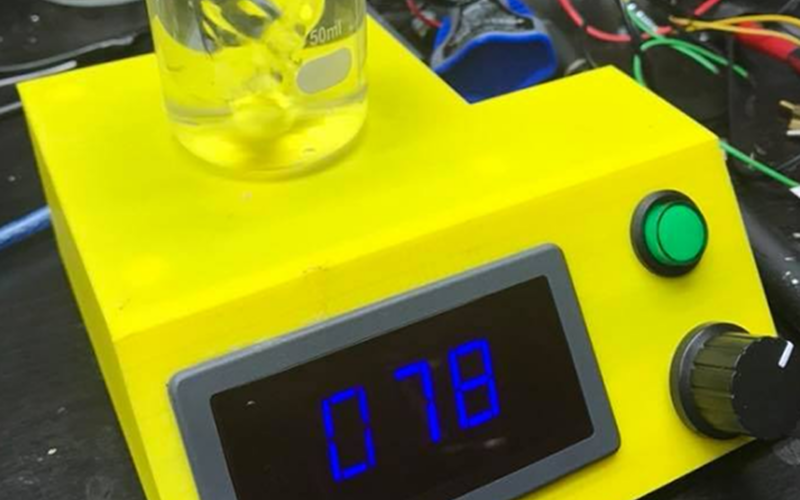If you’ve spent much time in a chemistry or biology lab, you’ve probably seen a magnetic stirrer. This is a little table that you put a beaker on. A little bar (often called a flea or a pill) goes in the solution and spins to stir the beaker’s contents. Simple versions are not that expensive, but nicer ones can cost a bit. [John] decided to build his own using 3D printing and the design is delightfully simple.
The electronics is nothing more than a PC fan, an off-the-shelf fan controller with a display, and a 3D printed bracket with some magnets. The flea is also 3D printed, although we’d probably buy cheap commercial fleas since they are usually coated with Teflon or some other non-reactive substance. Depending on what you are stirring, the reactivity of your 3D printed plastic and its porosity could be a concern. In addition, a commercial flea has a pivot ring that helps it spin smoothly, although we are sure the 3D printed one will work in most cases.
The 3D printed parts are on Thingiverse. Using the fan as a motor makes things simple. The controller and fan plug together, so there’s nothing to solder. If you do go with the 3D printed flea, [John] suggests using friction welding to seal the two halves, although you could use glue as long as you aren’t planning on stirring anything that would attack the glue.
We’ve seen stirrers before but this one is cheap, easy, and looks good. This would be a great project for a school or home lab that already has a 3D printer. Some stirrers have hot plates integrated and depending on the plastic you use, this might be a good upgrade.

















If you want to control and read the speed with an arduino, there is guidance at http://forum.arduino.cc/index.php?topic=114574.0
All the stirrers I have ever disassembled for repair use sequential induction to cause the pill to spin, there are no moving components inside the device, probably worth a quick look on Alibaba as the fan bearings introduce a well known point of failure
Interesting. When I was still in the lab (many, many moons ago), we routinely needed to do motor maintenance on the heated stirrers (shaft bushings and cleaning, mostly). The motor shaft run up to just below the hot surface in most units. I never used dedicated (non-hotplate) stirrers, so can not speak to them in those days.
The older ones (my IKA from 1998) have rotating magnets. i bought some broken ones and repaired them after building a construction with PC case fans like in his article.
my findings were the PC case fan stirrers are far to weak to spin anything of higher viscosity than water. The lab stirrers have REALLY strong magnets that would totally stop the fan if glued to it.
Yeah, but a computer fan would have a perfectly acceptable life span for a small lab that would consider building one of these–probably out of parts lying around.
Exactly. I don’t think anyone suggests outfitting a full time laboratory with this kind of gear. This is for light usage, or use where “real” equipment is unavailable or too expensive.
Please share models. There was one I knew of that used sequential induction and that business failed. I’m asking because we actually manufacture the Black MAXX stir plates and I always learn from competition.
Use an AC powered fan to have the power for higher viscosity liquids.
He can make it simpler! Use a pulley on the black knob and a belt to a magnet. “Turn Knob to Spin” :-)
are these PC fan motors generally brushless?. If so, I assume this will be reasonably safe with flammable solvents, in that they won’t create sparks?
These PC fan motors are brushless.and the larger ones make great stir plates. The motors won’t create a spark but don’t forget your control circuitry like your on/off switch and whatever you chose to use for speed control. I guess a lot depends on how flammable?